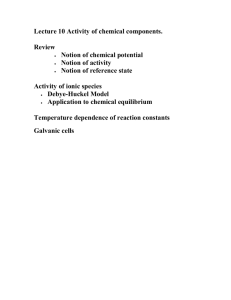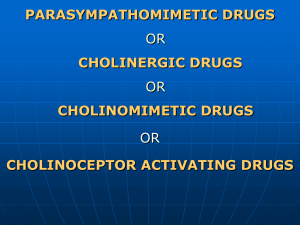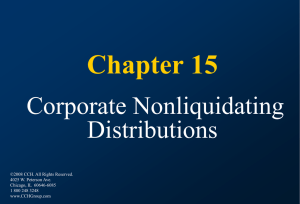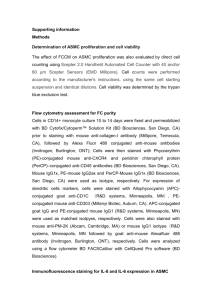Answer to reviewers
advertisement
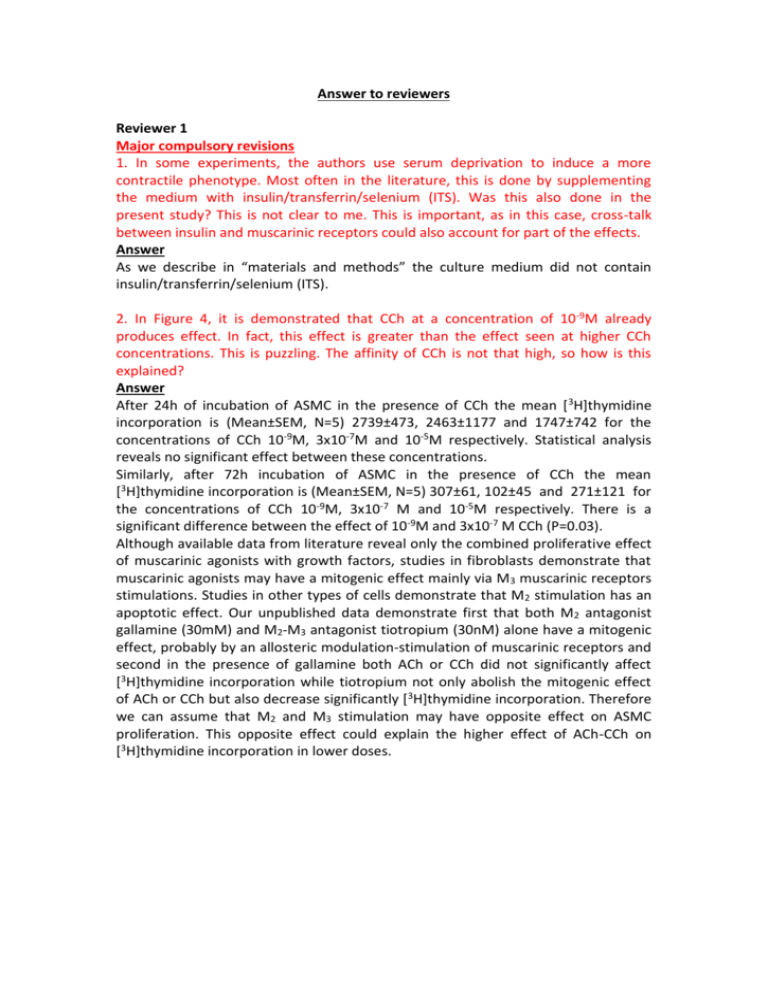
Answer to reviewers Reviewer 1 Major compulsory revisions 1. In some experiments, the authors use serum deprivation to induce a more contractile phenotype. Most often in the literature, this is done by supplementing the medium with insulin/transferrin/selenium (ITS). Was this also done in the present study? This is not clear to me. This is important, as in this case, cross-talk between insulin and muscarinic receptors could also account for part of the effects. Answer As we describe in “materials and methods” the culture medium did not contain insulin/transferrin/selenium (ITS). 2. In Figure 4, it is demonstrated that CCh at a concentration of 10 -9M already produces effect. In fact, this effect is greater than the effect seen at higher CCh concentrations. This is puzzling. The affinity of CCh is not that high, so how is this explained? Answer After 24h of incubation of ASMC in the presence of CCh the mean [ 3H]thymidine incorporation is (Mean±SEM, N=5) 2739±473, 2463±1177 and 1747±742 for the concentrations of CCh 10-9M, 3x10-7M and 10-5M respectively. Statistical analysis reveals no significant effect between these concentrations. Similarly, after 72h incubation of ASMC in the presence of CCh the mean [3H]thymidine incorporation is (Mean±SEM, N=5) 307±61, 102±45 and 271±121 for the concentrations of CCh 10-9M, 3x10-7 M and 10-5M respectively. There is a significant difference between the effect of 10-9M and 3x10-7 M CCh (P=0.03). Although available data from literature reveal only the combined proliferative effect of muscarinic agonists with growth factors, studies in fibroblasts demonstrate that muscarinic agonists may have a mitogenic effect mainly via M3 muscarinic receptors stimulations. Studies in other types of cells demonstrate that M2 stimulation has an apoptotic effect. Our unpublished data demonstrate first that both M 2 antagonist gallamine (30mM) and M2-M3 antagonist tiotropium (30nM) alone have a mitogenic effect, probably by an allosteric modulation-stimulation of muscarinic receptors and second in the presence of gallamine both ACh or CCh did not significantly affect [3H]thymidine incorporation while tiotropium not only abolish the mitogenic effect of ACh or CCh but also decrease significantly [3H]thymidine incorporation. Therefore we can assume that M2 and M3 stimulation may have opposite effect on ASMC proliferation. This opposite effect could explain the higher effect of ACh-CCh on [3H]thymidine incorporation in lower doses. control 10% FBS +ACh 10-7 M +CCh 10-9 M 3 [ H]thymidine incorporation (cpm) ### * 30000 ** ### 20000 7000 6000 5000 4000 3000 2000 1000 0 *** *** ** ** ** N=10 +gallamine 10mM N=10 +tiotropium 30nM N=10 In order to improve the manuscript we have removed Fig. 4. However, the increased thymidine incorporation in cells incubated with ACh or CCh is displayed in Fig.7 of the revised manuscript. 3. The manuscript suddenly takes an unexpected turn in Figure 7. Here, it is demonstrated that prolonged serum deprivation is required to expose a mitogenic effect of muscarinic receptor agonism, which is due to upregulation of the muscarinic receptor. While these data are of interest, and in fact represent the key novel data in the manuscript, in my opinion, these data should be presented directly after Figure 4. Answer The order of the data has been changed and the above data, as well as data obtained by cell counting are provided in Fig. 8 of the revised manuscript. 4. Further to point 3, these data call for additional experiments as the thymidine data shown in Figures 4 and 6 are collected using an entirely different experimental design and can therefore not be used in the context of the data shown in Figures 7 and further. My suggestion would be to remove Figure 4 and 6 from the manuscript and present Figure 5 after the current Figure 8. If the authors wish to retain thymidine incorporation data, these should be newly collected using the design shown in Figure 7-8. Answer The data that are presented in the revised manuscript are according to your suggestions. However, we maintained the thymidine experiments as they were (Fig.7), since we believe that it is important to show that muscarinic receptors can affect the capability of ASMCs to synthesize DNA even when they are not enriched with muscarinic receptors (Discussion section page 16). 5. Can the reduced responsiveness to CCh and ACh in Figure 10-11 not simply be due to desensitization/downregulation of the muscarinic receptor? Although I understand the rationale for these experiments, this represents an alternative explanation that at the very least should be discussed. Answer Data presented in this study leads us to the assumption that this effect is due to downregulation of M3 receptors, since these receptors are the main receptors that are involved in the cell contraction and their number is decreased in the cells that have the proliferative phenotype. There might of course be other explanations for the decrease in the cell responsiveness (Gosens et al 2004, reference 20). Furthermore, we observed a decrease in smooth muscle protein expression after prolonged incubation with muscarinic agonists. Since these proteins are necessary for the cell contraction, their expression can affect the cell responsiveness to contractile stimuli (Discussion section, page 15). 6. The paper by Gosens et al (2004) is not in agreement with the current findings (discussion page 16) as this paper shows that the reduction in contractile protein expression is not associated with increased proliferative behavior. Answer Even though Gosens et al 2004 found that in bovine tracheal smooth muscle muscarinic agonists decrease the expression of contractile proteins, as well as the cell responsiveness, which is in agreement with the results from our study, they did not find any alteration in the proliferative capacity. However, our experiments were performed in isolated rabbit tracheal smooth muscle cells and some differences can be due to differences between animals or between tissue and isolated cells. Minor compulsory revisions 1. Figure 1 and 2 can be merged into one Figure. In addition, please use arrows on Figure 1 to clarify the phenotype that is meant in the text. Further, higher resolution images and reduction of the background fluorescence for Figure 2 would improve the quality of this Figure substantially. Answer We have added arrows showing the cells in question and the use of colored figures rather than black and white has improved the quality of the figures. The data from former Figure 2 are now presented in the new figures 2, 3 and 4 together with the respective data from Western blot analysis of contractile protein expression. 2. The font used in Figure 3 and further is very difficult to read. Please provide a better font quality. Answer We have changed the font. 3. It is unclear what the asterisks in Figure 3 indicate: significance relative to control (same day) or control (day 0)? Answer The asterisks indicate significance relative to control of the same day. However, in the revised manuscript we show the quantification in Western blots only from day 15, since the effect was more obvious that day (Fig. 2. 3. 4) 4. The Western blot in Figure 5A is of insufficient quality due to unequal loading. Please provide a better example. Answer This figure was removed from the revised manuscript, since the information that muscarinic agonists activate the MAPK and PI3K signaling pathways is provided by the use of these pathways’ inhibitors in Fig.7 and Fig.9 5. PD89005 should be PD98059? Answer PD98059 is now corrected. Reviewer 2 If the cell cycle of rabbit ASM cells is +/- 50 h, how do the authors explain: 1. the strong increase in cell number after 24 h of incubation with FBS and ACh/CCh? 2. the lack of further increase after 24 h when cells are stimulated for up to 5 days with ACh/CCh, whereas FBS stimulation increases cell number up to day 4? Answer 1. The cells that are incubated in the culture conditions represent a mixed population of cells that have different phenotypes and therefore different proliferative capabilities. We have observed increased proliferation in the first 24h of incubation with other factors as well, such as insulin (Papagianni et al Exp Clin Endocrinol Diabetes 2007,115(2):118–23) or gender hormones (Stamatiou et al Steroids 2011, 76: 400–408). 2. FBS contains a mix of growth factors that are capable of sustaining the maximum proliferation in ASMCs, whereas muscarinic agonists can stimulate the cell proliferation through causing a shift of the cells to the proliferative phenotype, but prolonged incubation can lead to a decrease in muscarinic receptors and therefore the agonists can not affect the cell in the same degree. The authors claim that the effect of ACh/CCh on DNA synthesis in dose-independent. One could argue that this effect is dose-dependent (at 24 and 72 h) but that the effect of these agonists decreases with increasing concentrations. Answer We do agree with your observation, as well as with the first reviewer’s 2 nd comment, which is similar to yours. Our explanation is that after 24h of incubation of ASMC in the presence of CCh the mean [3H]thymidine incorporation is (Mean±SEM, N=5) 2739±473, 2463±1177 and 1747±742 for the concentrations of CCh 10-9M, 3x10-7M and 10-5M respectively. Statistical analysis reveals no significant effect between these concentrations. Similarly, after 72h incubation of ASMC in the presence of CCh the mean [3H]thymidine incorporation is (Mean±SEM, N=5) 307±61, 102±45 and 271±121 for the concentrations of CCh 10-9M, 3x10-7 M and 10-5M respectively. There is a significant difference between the effect of 10-9M and 3x10-7 M CCh (P=0.03). Although available data from literature reveal only the combined proliferative effect of muscarinic agonists with growth factors, studies in fibroblasts demonstrate that muscarinic agonists may have a mitogenic effect mainly via M3 muscarinic receptors stimulations. Studies in other types of cells demonstrate that M2 stimulation has an apoptotic effect. Our unpublished data demonstrate first that both M2 antagonist gallamine (30mM) and M2-M3 antagonist tiotropium (30nM) alone have a mitogenic effect, probably by an allosteric modulation-stimulation of muscarinic receptors and second in the presence of gallamine both ACh or CCh did not significantly affect [3H]thymidine incorporation while tiotropium not only abolish the mitogenic effect of ACh or CCh but also decrease significantly [3H]thymidine incorporation. Therefore we can assume that M2 and M3 stimulation may have opposite effect on ASMC proliferation. This opposite effect could explain the higher effect of ACh-CCh on [3H]thymidine incorporation in lower doses. control 10% FBS +ACh 10-7 M +CCh 10-9 M 3 [ H]thymidine incorporation (cpm) ### * 30000 ** ### 20000 7000 6000 5000 4000 3000 2000 1000 0 *** *** ** ** ** N=10 +gallamine 10mM N=10 +tiotropium 30nM N=10 In order to improve the manuscript we have removed Fig. 4. However, the increased thymidine incorporation in cells incubated with ACh or CCh is displayed in Fig.7 of the revised manuscript. The authors hypothesize that prolonged serum-deprivation leads to the conditions needed for the induction of proliferation by ACh/CCh. The DNA synthesis data the authors show seem to contradict that as increased thymidine incorporation is measured after 24 h stimulation. The cell number (MTT) however does only increase after prolonged serum deprivation. It would be really helpful if the authors would discuss this discrepancy in detail, so as to provide the readers with new insights and potential explanations. Answer The data presented in the revised manuscript (Fig. 7, Fig.8 ) give a better explanation of the observed effect. Muscarinic stimulation is capable of inducing increased thymidine incorporation after 24h of serum starvation, but there are not enough muscarinic receptors after this time of serum starvation in order to have an increase in cell number as well. However, when the M3 expression was altered due to prolonged starvation (7days) we did observe an increase in cell number as well, as demonstrated by both MTT and Trypan blue cell counting (Fig. 8) (Discussion section page 17). The authors use both DNA synthesis and the MTT assay to evaluate proliferation. These are both accepted methods which complement each other. However, in view of the points raised above, I would suggest the authors resort to cell counting in order to put these issues to rest. In addition, the advised protocol for proliferation studies is 48-72 h serum-deprivation for arrest of cells followed by 24h (DNA synthesis) or 48-96h (cell number) stimulation with growth factor. The current setup is not optimal. Answer We have done cell counting experiments that are shown in Fig. 8 of the revised manuscript. We have used the presented protocols for proliferation assessment in the past and have found that in the cells we use they are the most suitable, since 48h allow us to have increased cpm count in DNA synthesis. What is the explanation for the apparent discrepancy between the effects of the signaling inhibitors in the DNA synthesis and the MTT assay? Answer Thymidine incorporation was assessed after 24h of serum starvation (Fig.7), while cell number was estimated after 7days of serum starvation (Fig.8). The serum deprivation is responsible for alterations in the cell phenotype (induction of the contractile phenotype) that is accompanied by alteration in the receptor density and expression on the cell surface. Therefore, there may be differences in the activation of the signaling pathways that are involved in cell proliferation. However, both the activation of PI3K and MAPK signaling pathways is necessary for ASMC proliferation (Vignola et al 2003, reference 1). The authors seem to suggest that the induction of a proliferative phenotype, induced by ACh/CCh in their study goes hand in hand with decreased contractility/contractile protein expression. The authors also use ref. 21 (Gosens, Eur J Pharmacol) in this line of thought. Firstly, to point out the obvious, the authors are referring to the wrong paper: Gosens Br J Pharmacol 2004 is the correct paper. Secondly, the Gosens study clearly shows and thoroughly discusses the fact that the MCh-induced loss of contractility and contractile protein expression is NOT related to an increase in proliferative capacity, but rather molecular pathways involving calcium mobilization, as prolonged KCl stimulation has the same effect which is inhibited by a calcium channel inhibitor. Answer Gosens et al (Br J Pharmacol 2004, reference 20), have performed their experiments on bovine tracheal smooth muscle. The differences between animals, since Gosens uses bovine but we use rabbit trachea, as well as the fact that in that study the smooth muscle proliferation was estimated in tissues, whereas our experiments were performed in isolated primary cell cultures can be an explanation to the observed differences. Even though Gosens et al show that the MCh effect on proliferation might not be exclusive, since KCl stimulation had the same effect, in our study we show that the downregulation in M3 receptors (Fig.5) goes hand in hand with reduced responsiveness (Fig.6), as well as with the cell shift to the proliferative phenotype (Fig. 1, 2, 3, 4, 7, 8). The authors suggest that 7 days of serum-deprivation induces a contractile phenotype. The data in this study actually suggests otherwise. Table 1 and Fig 3 show that these cells have not acquired a contractile phenotype as the % of contractile protein-positive cells is not different between day 3 and 7, and the contractile protein expression in cell lysates shows no difference in expression between FBS and serum-free conditions on day 7. This somewhat, or perhaps largely, undermines the hypothesis that the induction of a contractile phenotype is required to enable ACh/CCh-induced proliferation. Answer In our experiments serum starvation for 7 days increased the percentage of cells that express α-actin or SM-MHC. This result is not statistically significant. The effect of serum starvation on the percentage of cells that express α-actin and SM-MHC is statistically significant on day 15. The percentage of ASMCs expressed desmin remained relevant constant after serum starvation for 3-15 days (see below table) Days of culture of serum starved ASMCs Percentage of 0 3 7 15 α-actin 56.6±3.0 16.3±4.0 19.5±2.3 41.2±6.0# SM-MHC 34.4±13.5 12.7±0.8 18.5±2.6 19.9±1.4# desmin 25.9±6.0 18.2±4.5 20.0±1.1 17.9±0.5 cells No changes were measured in the ratio of α-actin, myosin heavy chain (MHC) or desmin to β-actin in cells incubated for 3-15 days in serum free medium (table below). Days of culture Percentage of cells 0 3 7 15 α-actin 0.57±0.13 0.66±0.11 0.42±0.99 0.89±0.10 SM-MHC 0.9±0.08 1.02±0.02 0.94±0.1 1.25±0.2 desmin 053±0.01 0.60±0.06 0.60±0.04 0.68±0.5 Even though, the above results did not demonstrate that serum deprivation for 7 days causes a shift of ASMC phenotype to contractile, the purpose of our study was not the investigation of the effect of serum deprivation on ASMC phenotype but the effect muscarinic agonist. Our experiments clearly demonstrated the muscarinic agonist-induced shift of ASMC phenotype to synthetic/proliferative one. As far as the study of relevance of phenotype to ASMC proliferation is concerned, we focused mainly on the results that clearly demonstrate that serum deprivation increased significantly M3 receptors on ASMC, since [3H]NMS binding in serum deprived cells was increase from 18.5±0.4 on day 3 to 27.5±0.9 and 35.03±8 on day 15 respectively (Fig. 5). General point: the results should be discussed thoroughly; the discussion section is too speculative and offers little explanation for the observed effects. Answer We have changed the Discussion section

